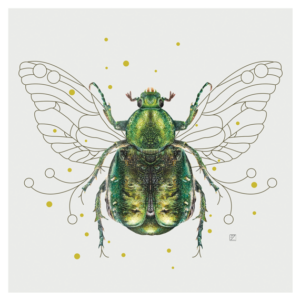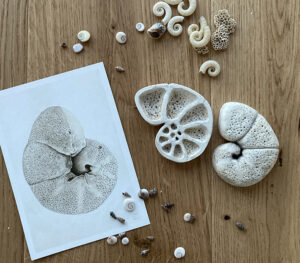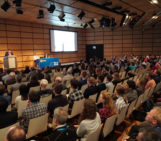
This week – on 24 January – the world observed the International Day of Education. At EGU, it felt like the perfect time for us to explore the intersection of science and art, and how they can be used in creative ways to educate and inform people regardless of their age and background. I spoke to Heike Jane Zimmermann who is an illustrator and sculptor with a particular passion for ecological science.
Read on for excerpts from our conversation!
Hi Jane, it’s very kind of you to spend some time doing this interview with us! So let’s begin with asking you how you describe yourself? Do you prefer being called a science artist or more broadly speaking – an illustrator and sculptor?
Hi and thanks for having me here 😉 I see myself more as an artist and illustrator who is interested in highlighting the small, often neglected worlds around us, bringing awareness to animals and plants that are facing extinction, and drawing out the intimate relationships that weave our planetary ecosystem together. For this I like to explore different media and approaches, like sculpturing, to add an extra story to my artwork. Science and all the amazing people I meet within it, is an unrivalled platform for me to get deeper insights into these worlds, and to engage with them in more meaningful ways in my artwork and illustrations.
Could you tell us about how your unique career journey began? Did you always know you wanted to do this or did inspiration strike later?
I think I knew from the beginning of my life that I wanted to do something with art. As soon as I could hold a pencil in my hands, I drew figures on my toys, doors and walls, which didn’t amuse my mum! I also became very interested in nature and the oceans, and in my teens I thought about becoming a marine biologist. But I couldn’t give up drawing. I went on to study graphic design, which gave me a good grounding in design, but I continued to illustrate and explore nature in my spare time. Then I decided to start my own business as an artist and illustrator – which was the best decision of my life! It wasn’t always easy, but I stuck to the plan and it paid off. From then on I grew more and more into what I loved and met incredible people on the way, worked with scientists, museums and also in many education projects with children. Through all this I have gained more knowledge and I am really curious to see what else the future will bring.
(Left: Chaferbeetle and Right: Mushroom Snail by Heike Jane Zimmermann
I particularly loved your work ‘Deep Sea Arctic Foraminifera‘ and was fascinated by how you produced watercolours from arctic deep sea sediment. Could you take us through your process with that project?
Oh yes, I met Giuliana Panieri (Professor in Geology) a few years ago and we realised we both shared an interest in small creatures. She studies foraminifera, which I had never heard of and I immediately fell in love with these little creatures (and soon enough, we became good friends). She then took me on one of her Arctic cruises (AKMA 2 – Ocean Senses) as an EGU Artist in Residence to gain a deeper understanding of our oceans and the world of foraminifera. That was incredible. As an artist, I research a lot about the object or story that I want to draw. I especially love drawing in details and realistically to show the beauty of our nature. But I also often draw fiction works to add a fantastic element into the drawing, or something a little `extra` that will make it even more strange and draw our imagination into the artwork.
Painting realistically is not easy with foraminifera because of their size. On the boat, I joined several scientists in their laboratories and couldn’t believe my eyes when I looked through their microscopes. Foraminifera have incredibly beautiful shapes and forms and I wanted to draw them large enough to show how diverse and beautiful they are!
I took some sediment samples we collected on the cruise and turned them into pigments and watercolour in my art studio. This is a very interesting process itself that takes a lot of learning and experimentation. Nowadays pigments are mostly made in a synthetic way, but I’m inspired by the fact that artists in earlier times created colours from natural materials. As an artist, I feel that this process brings me even closer to the object I want to draw and also adds a unique story to my paintings. The painting you mention has actually also been accepted for the Artists for Conservation Exhibition 2022 in Canada and can also be seen in the annual printed book published by the Artists for Conservation.
The above picture is an example of Jane’s foraminifera sculpturing.
Last year, EGU selected you as one of our Artists in Residence and you attended the 2023 General Assembly. What was that experience like for you?
That was amazing but also stressful in a positive way 😉 I wanted to talk to literally everybody but the time was unfortunately too short. A lot of scientists came to me for a chat and my booth turned into a little social hub, which I really loved. Many asked me how to incorporate art into their work to make it more interesting, and I was happy to show how they can use clay for sculpturing as a science communication tool for teaching. It is an old medium since the time of the Stone Age when stones, clay, wood, etc. were used in similar ways .. and also clay is a kind of easy medium to work with. I love the three-dimensionality of it; to be able to show something from both its in- and outside.
Together with Giuliana Panieri I’m working on some really great projects for kids and sculpting with clay is one of them. We have, for example, created two foraminifera figures, called Nina & Berry, which help us teach pupils about foraminifera in a playful way, and actually not just kids! One time, she took these two figures on a plane and everybody around her, including the pilot, wanted to know what they were. So here you go, this pilot knows, at least, something about foraminifera now!
All of that sounds truly wonderful! Finally, do you have any advice or words of encouragement for others looking to do what you do?
I think looking back on my journey and experience I can just say: follow your passion and do what you love, have fun in what you do and some courage, even if the way is sometimes challenging. Talk to people and make new connections …. I truly believe all this will send you on the right path in your creative or learning journey.






